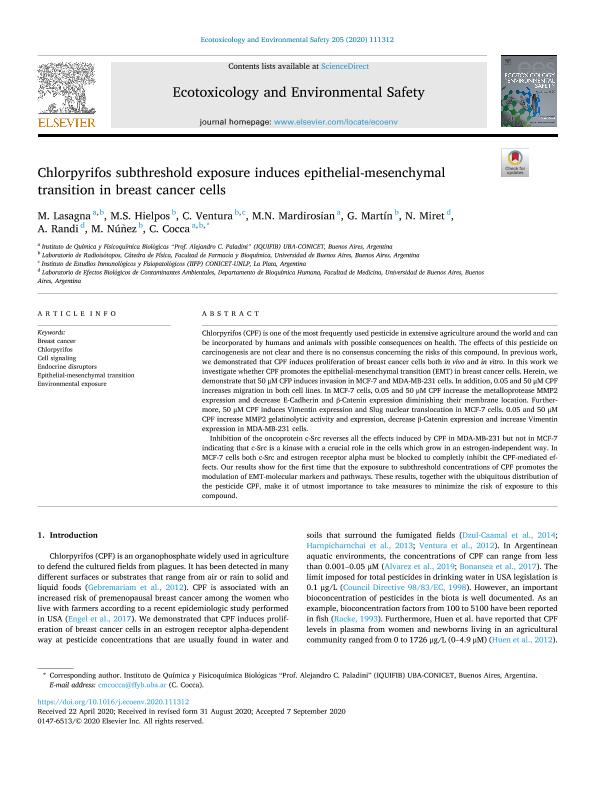Artículo
Chlorpyrifos subthreshold exposure induces epithelial-mesenchymal transition in breast cancer cells
Lasagna, Marianela ; Hielpos, María Soledad
; Hielpos, María Soledad ; Ventura, Clara
; Ventura, Clara ; Mardirosian, Mariana Noelia
; Mardirosian, Mariana Noelia ; Martín, G.; Miret, Noelia Victoria
; Martín, G.; Miret, Noelia Victoria ; Randi, Andrea Silvana
; Randi, Andrea Silvana ; Núñez, M.; Cocca, Claudia Marcela
; Núñez, M.; Cocca, Claudia Marcela
 ; Hielpos, María Soledad
; Hielpos, María Soledad ; Ventura, Clara
; Ventura, Clara ; Mardirosian, Mariana Noelia
; Mardirosian, Mariana Noelia ; Martín, G.; Miret, Noelia Victoria
; Martín, G.; Miret, Noelia Victoria ; Randi, Andrea Silvana
; Randi, Andrea Silvana ; Núñez, M.; Cocca, Claudia Marcela
; Núñez, M.; Cocca, Claudia Marcela
Fecha de publicación:
12/2020
Editorial:
Academic Press Inc Elsevier Science
Revista:
Ecotoxicology and Environmental Safety
ISSN:
0147-6513
Idioma:
Inglés
Tipo de recurso:
Artículo publicado
Clasificación temática:
Resumen
Chlorpyrifos (CPF) is one of the most frequently used pesticide in extensive agriculture around the world and can be incorporated by humans and animals with possible consequences on health. The effects of this pesticide on carcinogenesis are not clear and there is no consensus concerning the risks of this compound. In previous work, we demonstrated that CPF induces proliferation of breast cancer cells both in vivo and in vitro. In this work we investigate whether CPF promotes the epithelial-mesenchymal transition (EMT) in breast cancer cells. Herein, we demonstrate that 50 μM CFP induces invasion in MCF-7 and MDA-MB-231 cells. In addition, 0.05 and 50 μM CPF increases migration in both cell lines. In MCF-7 cells, 0.05 and 50 μM CPF increase the metalloprotease MMP2 expression and decrease E-Cadherin and β-Catenin expression diminishing their membrane location. Furthermore, 50 μM CPF induces Vimentin expression and Slug nuclear translocation in MCF-7 cells. 0.05 and 50 μM CPF increase MMP2 gelatinolytic activity and expression, decrease β-Catenin expression and increase Vimentin expression in MDA-MB-231 cells. Inhibition of the oncoprotein c-Src reverses all the effects induced by CPF in MDA-MB-231 but not in MCF-7 indicating that c-Src is a kinase with a crucial role in the cells which grow in an estrogen-independent way. In MCF-7 cells both c-Src and estrogen receptor alpha must be blocked to completly inhibit the CPF-mediated effects. Our results show for the first time that the exposure to subthreshold concentrations of CPF promotes the modulation of EMT-molecular markers and pathways. These results, together with the ubiquitous distribution of the pesticide CPF, make it of utmost importance to take measures to minimize the risk of exposure to this compound.
Archivos asociados
Licencia
Identificadores
Colecciones
Articulos(IQUIFIB)
Articulos de INST.DE QUIMICA Y FISICO-QUIMICA BIOLOGICAS "PROF. ALEJANDRO C. PALADINI"
Articulos de INST.DE QUIMICA Y FISICO-QUIMICA BIOLOGICAS "PROF. ALEJANDRO C. PALADINI"
Articulos(OCA HOUSSAY)
Articulos de OFICINA DE COORDINACION ADMINISTRATIVA HOUSSAY
Articulos de OFICINA DE COORDINACION ADMINISTRATIVA HOUSSAY
Citación
Lasagna, Marianela; Hielpos, María Soledad; Ventura, Clara; Mardirosian, Mariana Noelia; Martín, G.; et al.; Chlorpyrifos subthreshold exposure induces epithelial-mesenchymal transition in breast cancer cells; Academic Press Inc Elsevier Science; Ecotoxicology and Environmental Safety; 205; 12-2020; 1-13
Compartir
Altmétricas



